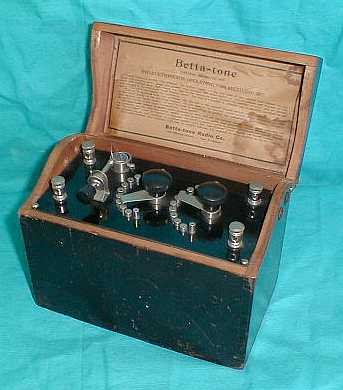I'm sorry to say I don't recall the inverter for car radios... though I use one on my golf cart, for christmas lights, and toys like a PA system, and plug in gizmos... The vibrator looks interesting... Would make a big hit on those late, late night TV commercials.

My aunt Yvonne had a 39 Chrysler with a 78RPM record player built in where the glove compartment used to be. The needle didn't bounce around as much as the ones on the later LP's.
My personal radio was a Bettatone (below)... tuned with a cats whisker. My steam radiator as a ground, and the metal bedspring as an antenna.
......................................................................
Need confirmation for this, but interesting it it's true.
Since I have so many low voltage charger/power supplies, it's quite interesting to note that between Voltage, Amps, and the size/shape of the connector... very few of these are duplicates. Voltage ranges ... 2, 2.5, 3.2, 3.5, 4.5, 5.0, 6.0 7.2, 9.0 12.0, and several printer and laptop power supplies of varying higher voltages. The connectors are very different... outside diameters may have 3 different size inside diameters, and between specialty connectors as in
different phones, and the four major different USB connectors (maybe more)...
..finding a replacement for a missing power supply often drives people to the $15.00 original replacement... Thus my buying them at resale for a quarter or less.
Discovery... that needs confirmation. I can usually match voltage and connector from my stash, but have been nervous about the differing amperages shown. in trying to find out if varying amperages would cause "burn out" problems, or "insufficient power"... I came across a battery information site that said... the amperage had to be at least equal to the original equipment, but if it was higher, no harm would be done to the battery or appliance, as long as the voltage was correct.
I have replaced a powersupply rated @ 6V .7Amp with one rated @6V 2amp... so far with no ill effects.
Would like confirmation of that... ?? anyone?
.....................................
One more... about that Hair dryer in the bathroom that electrocutes all of those bathtub victims on TV... I assume the the GFI would save a life... but... if no GFI... would the 15 amp fuse blow? DW refuses to let me test the theory.



